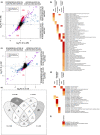Experimental sexual selection reveals rapid evolutionary divergence in sex-specific transcriptomes and their interactions following mating
- PMID: 35437824
- PMCID: PMC9325514
- DOI: 10.1111/mec.16473
Experimental sexual selection reveals rapid evolutionary divergence in sex-specific transcriptomes and their interactions following mating
Abstract
Post copulatory interactions between the sexes in internally fertilizing species elicits both sexual conflict and sexual selection. Macroevolutionary and comparative studies have linked these processes to rapid transcriptomic evolution in sex-specific tissues and substantial transcriptomic post mating responses in females, patterns of which are altered when mating between reproductively isolated species. Here, we tested multiple predictions arising from sexual selection and conflict theory about the evolution of sex-specific and tissue-specific gene expression and the post mating response at the microevolutionary level. Following over 150 generations of experimental evolution under either reduced (enforced monogamy) or elevated (polyandry) sexual selection in Drosophila pseudoobscura, we found a substantial effect of sexual selection treatment on transcriptomic divergence in virgin male and female reproductive tissues (testes, male accessory glands, the female reproductive tract and ovaries). Sexual selection treatment also had a dominant effect on the post mating response, particularly in the female reproductive tract - the main arena for sexual conflict - compared to ovaries. This effect was asymmetric with monandry females typically showing more post mating responses than polyandry females, with enriched gene functions varying across treatments. The evolutionary history of the male partner had a larger effect on the post mating response of monandry females, but females from both sexual selection treatments showed unique patterns of gene expression and gene function when mating with males from the alternate treatment. Our microevolutionary results mostly confirm comparative macroevolutionary predictions on the role of sexual selection on transcriptomic divergence and altered gene regulation arising from divergent coevolutionary trajectories between sexual selection treatments.
Keywords: Sfps; ejaculate-female interactions; experimental evolution; female post mating response; reproduction; reproductive isolation; sexual conflict.
© 2022 The Authors. Molecular Ecology published by John Wiley & Sons Ltd.
Conflict of interest statement
The authors declare that they have no conflict of interest.
Figures




References
-
- Alexa, A. , & Rahnenfuhrer, J. (2010). topGO: enrichment analysis for gene ontology. R package version 2.
-
- Anderson, W. W. (1974). Frequent multiple insemination in a natural population of Drosophila pseudoobscura . The American Naturalist, 108, 709–711. 10.1086/282949 - DOI
Publication types
MeSH terms
LinkOut - more resources
Full Text Sources
Molecular Biology Databases

